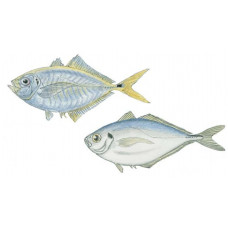Latin name
Chloroscombrus chrysurus; Chloroscombrus orqueta
Other names
French: sapater; Spanish: casabe.
Identification
Although the bumper has a low back, it has an elongated belly and a very slender body. While its overall coloration is silvery, it has greenish hues on its back and yellow highlights on its flanks and belly. It also has a yellowish tail. It has a black spot on each gill cover and a black saddle at the base of the tail.
Distribution
Widely distributed in tropical and warm temperate waters of the Atlantic Ocean. Western Atlantic: from Massachusetts along U.S. coast to Bermuda; Gulf of Mexico, Caribbean Sea (except the Cayman Islands); along coast of South America to Uruguay. East Atlantic: From Mauritania to Angola, including Cape Verde.
Habitat
They live in coastal waters at depths of 0 to 110 m, enter mangrove lagoons and estuaries.
Size
The bumper rarely weighs more than half a pound and can reach a length of 10 inches in the western Atlantic or 12 inches in the eastern Atlantic.
Life history and Behavior
Marine pelagic fish. In the estuaries of the Central-East Atlantic, female boomers reach sexual maturity at 13.7-15.4 cm in body length, and males at 14.7 cm in body length. In the Bay of Campeche, they spawn year-round with a maximum in spring and summer, in areas of water depths less than 40 m. When caught, they make grunting sounds.
Food and feeding habits
They feed on small fish, cephalopods, zooplankton.
Reproduction
No information
| Classification | |
| Phylum | Chordata |
| Class | Actinopterygii |
| Squad | Carangiformes |
| Family | Carangidae |
| Genus | Chloroscombrus |
| Species | C. chrysurus; C. orqueta |
| Features | |
| Conservation status | Least Concern |
| Habitat | Littoral |
| Life span, years | No information |
| Maximum body weight, kg | 4 |
| Maximum length, cm | 65 |
| Sailing speed, m/s | No information |
| Threat to people | Edible |
| Way of eating | predator |
Bumper, Atlantic; Bumper, Pacific
Tags: Bumper, Atlantic; Bumper, Pacific

